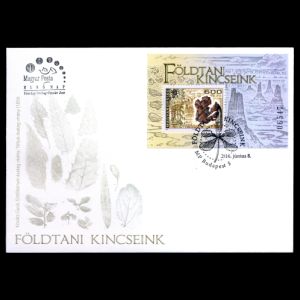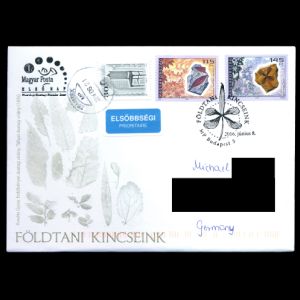Hungary 2016 "Hungary’s Geological Treasures"
| <prev | back to index | next> |
| Issue Date | 23.02.2016 |
| ID | Michel: 5826-5827, Bl. 387; Scott: 4389-4390, 4391; Stanley Gibbons: 552-5543, MS5544; Yvert et Tellier: 4642-4643, BF374; Category: pF |
| Designer | Jaksa Vlahovich, BA, Graphic Artist Kalman Szekely with support of Hungarian Natural History Museum |
| Stamps in set | 3 |
| Value |
HUF 115 - Daphnogene polymorpha HUF 145 - Raskya vetusta HUF 600 - Glyptostrobus europaeus |
| Emission/Type | commemorative |
| Issue places | Budapest |
| Size (width x height) | stamps: 40mm x 30 mm, Souvenir-Sheet: 90mm x 60mm |
| Layout | Sheets of 50 and a Souvenir-Sheet of 1 stamp |
| Products | FDC x2 |
| Paper | gummed postage stamp paper |
| Perforation | 12.50 x 12 |
| Print Technique | Offset lithography |
| Printed by | Penzjegynyomda Zrt. |
| Quantity | 200,000 stamp sets, 80,000 numbered Souvenir-Sheets |
| Issuing Authority | Magyar Posta |

On June 8, 2016, Hungarian Post Authority (Magyar Posta) issued the set of two stamps and a Souvenir-Sheet on the theme of Hungary’s geological treasures. Face value of these stamps are:
- HUF 115 (domestic non-priority standard letter or postcard)
- HUF 145 (domestic priority standard letter or postcard)
- HUF 600 (domestic priority letter up to 500 g)
The graphics of the stamp set and Souvenir-Sheet were made in watercolours and treated the theme of geological treasures in an individual interpretation which mixed fact and fantasy. On some Souvenir-Sheet a colour difference to an acceptable degree towards the primary colour magenta may be perceptible.
The design of the Souvenir-Sheet features Late Miocene swamp cypresses from Bukkabrany, while the fossil of a member of the laurel family from Ipolytarnoc and Early Oligocene plants from Obuda appear on the denominations of the set.
The latter shows a specimen of the fossil species Raskya vetusta in honour of the eminent Hungarian palaeobotanist Dr. Klara Rasky (1908-1971). An interesting aspect of the designs is that the graphic artist Kalman Szekely set the finds in their imagined original environments.
The fossilized remains of a swamp cypress forest were found 60 metres below the ground in an open-cast lignite mine near Bukkabrany in Borsod-Abauj-Zemplen county in July 2007. It is thought that this area was a swamp cypress forest on the northern shore of the Pannonian Sea in the Late Miocene about 7 to 8 million years ago.
 The cypresses were 30 to 40 metres high.
A sudden sandstorm or mudflow may have caused the trees to die, covering the lower part
of their trunks to a height of 6 metres which preserved them.
The cypresses were 30 to 40 metres high.
A sudden sandstorm or mudflow may have caused the trees to die, covering the lower part
of their trunks to a height of 6 metres which preserved them. The Ipolytarnoc Fossils Nature Conservation Area is a world renowned early Miocene palaeontological site and a European protected area, which was buried in a volcanic catastrophe similar to Pompeii 17 million years ago.
Scientific investigations in the area began in 1836 and it has been protected since 1944. Its most important fossilized remains are the shoreline layer bearing sharks' teeth, the enormous petrified trees of a subtropical forest, impressions of plants and the footprints of animals and fossils caught in the deluge of volcanic tuff.
The Tard Clay was deposited during the Early Oligocene. It is mined at Obuda where the clay is used for making bricks. Many varied specimens of fossilized plants typical of subtropical regions roughly 30 million years old were discovered, demonstrating the abundance and diversity of the vegetation that once existed in the area.
The FDC cover honours the palaeobotanist Gyula Kovats (1815-73), whose collections and work describing and classifying the finds laid the foundations of research into palaeobotany in Hungary. His books “The Fossil Flora of Erdobenye” and “The Fossil Flora of Tallya” were published in 1856, establishing palaeobotany in Hungary.
Products
| FDC (clean and circulated) | ||
 |
 |
 |
 |
 |
|
References

|
-
Technical details:
Hungarian Post, colnect. -
Ipolytarnoc Fossils Nature Conservation Area:
Wikipedia colnect.
Acknowledgements:
Many thanks to Dr. Peter Voice from Department of Geological and Environmental Sciences, Western Michigan University, for the draft page review.
| <prev | back to index | next> |